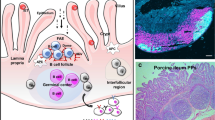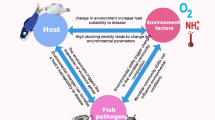Abstract
Low dose antibiotics have been used as growth promoters in livestock and fish. The use of antibiotics has been associated with reduced pathogen infections in livestock. In contrast, antibiotic growth promoter has been suspected of leading to disease outbreaks in aquaculture. However, this phenomenon is circumstantial and has not been confirmed in experimental conditions. In this study, we showed that antibiotic olaquindox increased the susceptibility of zebrafish to A. hydrophila infection. Olaquindox led to profound alterations in the intestinal microbiota of zebrafish, with a drastic bloom of Enterobacter and diminishing of Cetobacterium. Moreover, the innate immune responses of zebrafish were compromised by olaquindox (P<0.05). Transfer of microbiota to GF zebrafish indicated that while the immuo-suppression effect of olaquindox is a combined effect mediated by both OLA-altered microbiota and direct action of the antibiotic (P<0.05), the increased pathogen susceptibility was driven by the OLA-altered microbiota and was not dependent on direct antibiotic effect. Taken together, these data indicate that low level of OLA induced gut microbiota dysbiosis in zebrafish, which led to increased pathogen susceptibility.
Similar content being viewed by others
References
Araujo, F.G., Slifer, T.L., and Remington, J.S. (2002). Effect of moxifloxacin on secretion of cytokines by human monocytes stimulated with lipopolysaccharide. Clin Microbiol Infect 8, 26–30.
Bellmann, C., Tipping, A., and Sumaila, U.R. (2016). Global trade in fish and fishery products: an overview. Mar Policy 69, 181–188.
Brüssow, H. (2015). Growth promotion and gut microbiota: insights from antibiotic use. Environ Microbiol 17, 2216–2227.
Casewell, M., Friis, C., Marco, E., McMullin, P., and Phillips, I. (2003). The European ban on growth-promoting antibiotics and emerging consequences for human and animal health. J Antimicrob Chemother 52, 159–161.
Castanon, J.I.R. (2007). History of the use of antibiotic as growth promoters in european poultry feeds. Poult Sci 86, 2466–2471.
Cho, I., Yamanishi, S., Cox, L., Methé, B.A., Zavadil, J., Li, K., Gao, Z., Mahana, D., Raju, K., Teitler, I., Li, H., Alekseyenko, A.V., and Blaser, M.J. (2012). Antibiotics in early life alter the murine colonic microbiome and adiposity. Nature 488, 621–626.
Cox, L.M., Yamanishi, S., Sohn, J., Alekseyenko, A.V., Leung, J.M., Cho, I., Kim, S.G., Li, H., Gao, Z., Mahana, D., Zárate Rodriguez, J.G., Rogers, A.B., Robine, N., Loke, P., and Blaser, M.J. (2014). Altering the intestinal microbiota during a critical developmental window has lasting metabolic consequences. Cell 158, 705–721.
Coyne, M.J., Roelofs, K.G., and Comstock, L.E. (2016). Type VIsecretion systems of human gut Bacteroidales segregate into three genetic architectures, two of which are contained on mobile genetic elements. BMC Genomics 17, 58.
Defoirdt, T., Boon, N., Sorgeloos, P., Verstraete, W., and Bossier, P. (2007). Alternatives to antibiotics to control bacterial infections: luminescent vibriosis in aquaculture as an example. Trends Biotech 25, 472–479.
Faber, F., Tran, L., Byndloss, M.X., Lopez, C.A., Velazquez, E.M., Kerrinnes, T., Nuccio, S.P., Wangdi, T., Fiehn, O., Tsolis, R.M., and Bäumler, A.J. (2016). Host-mediated sugar oxidation promotes post-antibiotic pathogen expansion. Nature 534, 697–699.
Feckaninová, A., Košcová, J., Mudronová, D., Popelka, P., and Toropilová, J. (2017). The use of probiotic bacteria against Aeromonas infections in salmonid aquaculture. Aquaculture 469, 1–8.
Gao, P., Mao, D., Luo, Y., Wang, L., Xu, B., and Xu, L. (2012). Occurrence of sulfonamide and tetracycline-resistant bacteria and resistance genes in aquaculture environment. Water Res 46, 2355–2364.
Hai, N.V. (2015). Research findings from the use of probiotics in tilapia aquaculture: a review. Fish Shellfish Immunol 45, 592–597.
Halling-Sørensen, B. (2001). Inhibition of aerobic growth and nitrification of bacteria in sewage sludge by antibacterial agents. Arch Environ Contam Toxicol 40, 451–460.
Hermann, A.C., Millard, P.J., Blake, S.L., and Kim, C.H. (2004). Development of a respiratory burst assay using zebrafish kidneys and embryos. J Immunol Methods 292, 119–129.
Hornef, M. (2015). Pathogens, commensal symbionts, and pathobionts: discovery and functional effects on the host. ILAR J 56, 159–162.
Jeong, S.H., Song, Y.K., and Cho, J.H. (2009). Risk assessment of ciprofloxacin, flavomycin, olaquindox and colistin sulfate based on microbiological impact on human gut biota. Regul Toxicol Pharmacol 53, 209–216.
Khadem, A., Soler, L., Everaert, N., and Niewold, T.A. (2014). Growth promotion in broilers by both oxytetracycline and Macleaya cordata extract is based on their anti-inflammatory properties. Br J Nutr 112, 1110–1118.
Kim, M., Qie, Y., Park, J., and Kim, C.H. (2016). Gut microbial metabolites fuel host antibody responses. Cell Host Microbe 20, 202–214.
Lange, K., Buerger, M., Stallmach, A., and Bruns, T. (2016). Effects of antibiotics on gut microbiota. Dig Dis 34, 260–268.
Li, H., Wang, W., Mai, K., Ai, Q., Zhang, C., and Zhang, L. (2014). Effect of dietary olaquindox on the growth of large yellow croaker (Pseudosciaena crocea R.) and the distribution of its residues in fish tissues. J Ocean Univ China 13, 820–824.
Lillicrap, A., Macken, A., and Thomas, K.V. (2015). Recommendations for the inclusion of targeted testing to improve the regulatory environmental risk assessment of veterinary medicines used in aquaculture. Environ Int 85, 1–4.
Liu, Z., Liu, W., Ran, C., Hu, J., and Zhou, Z. (2016). Abrupt suspension of probiotics administration may increase host pathogen susceptibility by inducing gut dysbiosis. Sci Rep 6, 23214.
Looft, T., Johnson, T.A., Allen, H.K., Bayles, D.O., Alt, D.P., Stedtfeld, R.D., Sul, W.J., Stedtfeld, T.M., Chai, B., Cole, J.R., Hashsham, S.A., Tiedje, J.M., and Stanton, T.B. (2012). In-feed antibiotic effects on the swine intestinal microbiome. Proc Natl Acad Sci USA 109, 1691–1696.
Morgun, A., Dzutsev, A., Dong, X., Greer, R.L., Sexton, D.J., Ravel, J., Schuster, M., Hsiao, W., Matzinger, P., and Shulzhenko, N. (2015). Uncovering effects of antibiotics on the host and microbiota using transkingdom gene networks. Gut 64, 1732–1743.
Oliveri Conti, G., Copat, C., Wang, Z., D’Agati, P., Cristaldi, A., and Ferrante, M. (2015). Determination of illegal antimicrobials in aquaculture feed and fish: an ELISA study. Food Control 50, 937–941.
Oyarbide, U., Iturria, I., Rainieri, S., and Pardo, M.A. (2015). Use of gnotobiotic zebrafish to study Vibrio anguillarum pathogenicity. Zebrafish 12, 71–80.
Pamer, E.G. (2016). Resurrecting the intestinal microbiota to combat antibiotic-resistant pathogens. Science 352, 535–538.
Rivera-Chávez, F., Zhang, L.F., Faber, F., Lopez, C.A., Byndloss, M.X., Olsan, E.E., Xu, G., Velazquez, E.M., Lebrilla, C.B., Winter, S.E., and Bäumler, A.J. (2016). Depletion of butyrate-producing Clostridia from the gut microbiota drives an aerobic luminal expansion of Salmonella. Cell Host Microbe 19, 443–454.
Rolig, A.S., Parthasarathy, R., Burns, A.R., Bohannan, B.J.M., and Guillemin, K. (2015). Individual members of the microbiota disproportionately modulate host innate immune responses. Cell Host Microbe 18, 613–620.
Round, J.L., and Mazmanian, S.K. (2009). The gut microbiota shapes intestinal immune responses during health and disease. Nat Rev Immunol 9, 313–323.
Soler, L., Miller, I., Hummel, K., Razzazi-Fazeli, E., Jessen, F., Escribano, D., and Niewold, T. (2016). Growth promotion in pigs by oxytetracycline coincides with down regulation of serum inflammatory parameters and of hibernation-associated protein HP-27. Electrophoresis 37, 1277–1286.
Thaiss, C.A., Zmora, N., Levy, M., and Elinav, E. (2016). The microbiome and innate immunity. Nature 535, 65–74.
Ubeda, C., and Pamer, E.G. (2012). Antibiotics, microbiota, and immune defense. Trends Immunol 33, 459–466.
Xiong, W., Sun, Y., Zhang, T., Ding, X., Li, Y., Wang, M., and Zeng, Z. (2015). Antibiotics, antibiotic resistance genes, and bacterial community composition in fresh water aquaculture environment in China. Microb Ecol 70, 425–432.
Xu, D., Gao, J., Gillilland Iii, M., Wu, X., Song, I., Kao, J.Y., and Owyang, C. (2014). Rifaximin alters intestinal bacteria and prevents stress-induced gut inflammation and visceral hyperalgesia in rats. Gastroenterology 146, 484–496.e4.
Zapata, A., Diez, B., Cejalvo, T., Gutiérrez-de Frías, C., and Cortés, A. (2006). Ontogeny of the immune system of fish. Fish Shellfish Immunol 20, 126–136.
Zhang, Q., Cheng, J., and Xin, Q. (2015a. Effects of tetracycline on developmental toxicity and molecular responses in zebrafish (Danio rerio) embryos. Ecotoxicology 24, 707–719.
Zhang, Q.Q., Ying, G.G., Pan, C.G., Liu, Y.S., and Zhao, J.L. (2015b. Comprehensive evaluation of antibiotics emission and fate in the river basins of China: source analysis, multimedia modeling, and linkage to bacterial resistance. Environ Sci Technol 49, 6772–6782.
Zhu, S.M., Deng, Y.L., Ruan, Y.J., Guo, X.S., Shi, M.M., and Shen, J.Z. (2015). Biological denitrification using poly(butylene succinate) as carbon source and biofilm carrier for recirculating aquaculture system effluent treatment. Bioresour Tech 192, 603–610.
Acknowledgements
This work was supported by the National Basic Research Program of China (2015CB150605), the National Natural Science Foundation of China (31272672, 31572633), the Beijing Earmarked Fund for Modern Agro-industry Technology Research System (SCGWZJ 20161104-4), and the Fundamental Research Funds for the Central Public Welfare Research Institute (1610382016013).
Author information
Authors and Affiliations
Corresponding author
Electronic supplementary material
Rights and permissions
About this article
Cite this article
He, S., Wang, Q., Li, S. et al. Antibiotic growth promoter olaquindox increases pathogen susceptibility in fish by inducing gut microbiota dysbiosis. Sci. China Life Sci. 60, 1260–1270 (2017). https://doi.org/10.1007/s11427-016-9072-6
Received:
Accepted:
Published:
Issue Date:
DOI: https://doi.org/10.1007/s11427-016-9072-6




